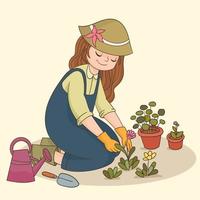The Ultimate Guide to Gardening for Beginners: Detailed Tips and Techniques for Growing a Thriving Garden
From comprehending your yard room to choosing the right plants and preparing the soil, we've obtained you covered. Get ready to release your environment-friendly thumb and develop an attractive, growing yard.
Understanding Your Garden Space
Comprehending your yard room is important for creating a prospering garden. This will assist you determine which plants will flourish in each location. home gardening for beginners.
Following, evaluate the dirt in your yard. Is it sandy, clay-like, or loamy? Understanding your dirt kind will certainly lead you in choosing the right plants and implementing suitable dirt modifications. Furthermore, think about the water drainage of your garden. Is it vulnerable to waterlogging or does it drain pipes rapidly? This details will certainly aid you make educated decisions concerning watering and plant placement.
These are little areas that might differ in temperature level or wetness levels compared to the rest of your yard. Make use of these variants to your benefit by growing heat-loving or moisture-loving plants in these locations.
Picking the Right Plants

Following, consider your gardening goals and choices. Are you seeking to expand vegetables, flowers, or a mix of both? Do you like low-maintenance plants or are you happy to place in additional initiative for high-yield crops? Consider the quantity of time, power, and resources you agree to spend in your yard.
Additionally, think about the room available in your yard. Take measurements and intend out the format of your plants. Think about the mature size of each plant and make certain they have sufficient room to grow without congestion each various other.
Finally, assume concerning the functionality of your plant options. home gardening for beginners. Will you be able to give the required care and maintenance for your selected plants? Take into consideration elements such as watering, feeding, pest control, and trimming
Preparing the Soil for Planting
When you have selected the appropriate plants for your growing garden, it's time to study the vital job of preparing the soil for growing. Prior to you start digging, it's essential to examine the top quality of your dirt. Take a sample and examination its pH degrees, as various plants thrive in various pH varieties. Adjust the pH if needed by including lime to increase it or sulfur to decrease it.

As soon as the dirt prepares, develop furrows or openings for growing. The deepness and spacing will certainly depend upon the certain demands of your picked plants, so describe the seed packets or plant labels for guidance. Carefully put the plants in their designated places, guaranteeing that the origins are covered with soil. Strongly push the dirt around the base of each plant to get rid of any air pockets.
As you water, be careful not to wash away the soil or damages the delicate plants. With correct dirt preparation, your yard will certainly be fully equipped to support the growth and success of your plants.
Watering and Fertilizing Techniques
After preparing the dirt for planting, it's important to recognize efficient watering and feeding methods to ensure the wellness and growth of your yard. It's crucial to strike an equilibrium when it comes to watering. Overwatering can result in root rot and various other illness, while underwatering can cause stunted development and wilting. The secret is to provide sufficient water to maintain the dirt continually moist but not saturated. If your plants need watering is by sticking your finger concerning an inch right into the dirt, one method to evaluate. It's time to water if it feels completely dry. When watering, go for the base of the plants, as moistening the leaves can encourage illness. As for feeding, it's vital to offer your plants the nutrients they require to grow. Organic plant foods, such as garden compost or well-rotted manure, are excellent options as they give a sluggish release of nutrients. It's finest to use plant foods in very early spring or late fall, following the directions on the package. Keep in mind to sprinkle your plants after fertilizing to assist the nutrients get to the origins. By understanding these watering and feeding methods, you'll be well on your means to a thriving garden.
Maintaining a Healthy And Balanced Garden
To maintain a healthy garden, you should regularly evaluate your plants for indicators of parasites or conditions. By doing this, you can catch any kind of issues beforehand and take the essential steps to avoid them from spreading and triggering damages to your entire yard. Seek any kind of unusual places on leaves, wilting or yellowing foliage, or openings in the leaves, as these can be signs of insects or conditions. It is essential to take instant activity. if you discover any of these signs.
One more approach is to urge useful pests like lacewings and ladybugs, which feed on yard pests. Planting flowers gardening for beginners such as marigolds, sunflowers, and daisies will bring in these useful bugs to your yard.
In addition to insects, diseases can likewise influence your plants. Proper spacing between plants and good air flow can additionally help prevent the spread of diseases.
Final Thought
By understanding your yard space, picking the right plants, preparing the dirt, and executing correct watering and feeding techniques, you can produce a successful garden. With patience and commitment, you'll quickly be taking pleasure in the appeal and bounty of your own prospering garden.
Make use of these variations to your benefit by growing moisture-loving or heat-loving plants in these locations.
